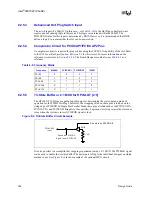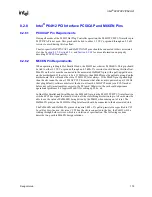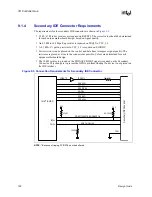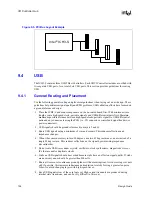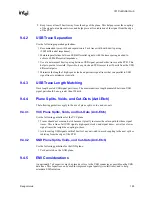
Design Guide
115
Intel
®
82870P2 (P64H2)
8.2.8
Intel
®
P64H2 PCI Interface PCIXCAP and M66EN Pins
8.2.8.1
PCIXCAP Pin Requirements
During all modes of the P64H2 Hot Plug Controller operation, the P64H2 PCI/PCI-X interface pin
PxPCIXCAP is not used. This pin should be tied to either 3.3 VCC or ground through an 8.2
k
Ω
resistor to avoid having this line float.
The slot-specific HxPCIXCAP1 and HxPCIXCAP2 pins should be connected to their associated
slot. See
, and
for more information on properly
decoding PCI/PCI-X capability.
8.2.8.2
M66EN Pin Requirements
When operating in Single Slot Parallel Mode, the P64H2 never drives PxM66EN. This pin should
be tied to either 3.3 VCC or ground through an 8.2 k
Ω
± 5% resistor to avoid having this line float.
M66EN on the slot must be connected to the associated HxM66EN pin with a pull-up/pull-down
on the motherboard. If the slot is to be a 33 MHz slot, then M66EN must be pulled to ground on the
motherboard. This will make the slot a 33 MHz PCI slot always. If the M66EN pin is pulled high,
then the slot cannot be run at 33 MHz PCI. This means that after a card is powered up at 33 MHz
(hot plug default), software must reset the bus to at least 66 MHz PCI mode (or a PCI-X mode)
before any software attempts accesses to the PCI card. Otherwise, the card could experience
operational problems if it requires M66EN for setting up PLLs, etc.
In Dual Slot Parallel and Serial Modes, the PxM66EN pin (on the P64H2 PCI/PCI-X interface) is a
switched PCI bus signal that must be tied to all the slots through isolation logic. All cards must be
able to see the value of PxM66EN being driven by the P64H2 when coming out of reset. The
HxM66EN pins (on the P64H2 Hot Plug Interface) should be connected to their associated slots.
The PxM66EN and HxM66EN pins each require 5 k
Ω
± 5% pull-up resistors as specified in
PCI
Local Bus Specification, Revision 2.2
. When the slot is connected to the bus, the P64H2 will be
sinking through both resistors, which is a violation of specification. The following sections
describe two possible M66EN design solutions.
Summary of Contents for Xeon
Page 24: ...Introduction 24 Design Guide This page is intentionally left blank ...
Page 30: ...Component Quadrant Layout 30 Design Guide This page is intentionally left blank ...
Page 52: ...Platform Clock Routing Guidelines 52 Design Guide This page is intentionally left blank ...
Page 66: ...System Bus Routing Guidelines 66 Design Guide This page is intentionally left blank ...
Page 118: ...Intel 82870P2 P64H2 118 Design Guide This page is intentionally left blank ...
Page 146: ...I O Controller Hub 146 Design Guide This page is intentionally left blank ...
Page 148: ...Debug Port 148 Design Guide This page is intentionally left blank ...
Page 210: ...Schematic Checklist 210 Design Guide This page is intentionally left blank ...
Page 220: ...Layout Checklist 220 Design Guide This page is intentionally left blank ...
Page 222: ...Schematics 222 Design Guide This page is intentionally left blank ...




